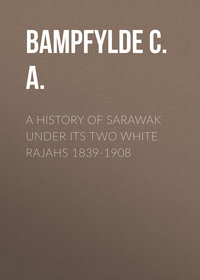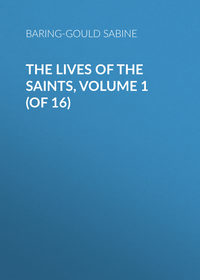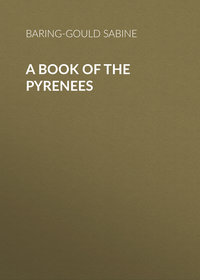 полная версия
полная версияA Book of The Riviera
The clock at the Quirinale was striking three-quarters after two when Miollis made a sign to commence operations. The gates remained fast shut. The French soldiers tried to scale the garden walls, but failed; and men were sent in hot haste to borrow ladders for the purpose. These were obtained; but the first who surmounted the wall, lost his footing in attempting to descend on the farther side, and broke his leg. Another judgment! and again levelled at very poor game. He was a mulatto. General Radet, with a small following, made good his entrance into the palace through a window, and reached the grand staircase, which was crowded with papal servants, who offered but a feeble and half-hearted resistance, and were at once overpowered.
In the meantime the other party had effected an entrance over the garden wall.
Radet lost no time in gaining the Pope’s apartments. One or two doors had to be broken open, and then he reached the ante-chamber, where were drawn up the Papal Swiss guards. They at once laid down their arms, without a show of fight. When a couple more doors had been forced Radet reached the Pope’s audience chamber. Pius had rigged himself up so as to produce an impression. He wore a white silk cassock, a mozetta on his head of crimson silk, and a gold stole. He was seated at a table with Cardinals Pacca and Despuig. But Radet was not overawed, as were the Gauls by the sight of the white-bearded senators. Advancing, he said, with courtesy, —
“I have a most painful and trying commission to execute, but I have sworn fidelity and obedience to the Emperor, and I must obey his orders. On the part, therefore, of his Majesty, I have to intimate to your Holiness that you must renounce all temporal sovereignty over Rome and the Roman States.”
The Pope replied calmly: “I believed that I had complied with the Emperor’s orders, when I took the oath of fealty and obedience to him. We cannot cede or renounce what is not our own. The temporal power belongs to the Roman Church, and we are only the administrators. Must we go alone?”
“No; your Holiness can take Cardinal Pacca with you.”
A quarter of an hour afterwards the Pope, wearing his red hat and mantle, left the Quirinale, and, along with Cardinal Pacca, entered a carriage. General Radet and an officer took seats opposite, and the blinds were drawn down on the side on which sat the Pope.
When the carriage was on its way Pius suddenly exclaimed: “I have forgotten to bring my money; all I have in my pocket is twenty bajocchi.”
“And I,” said the Cardinal, “have only five.”
“Then,” said the Pope, “this may be regarded as a truly apostolic journey, with one franc seventy-five centimes between us.”
The Pope was conveyed somewhat hastily to Savona, where he was well received, but kept under surveillance for nearly six years.
Savona was made the capital of the department of Montenotte by Napoleon. The see was founded in 680. From 1499 to 1528 it was entirely in the hands of the Della Rovere and Riario families for five successions. In 1098 it was the see of the bishop Peter Grossulano, whose story is strange enough. Anselm, Archbishop of Milan, died at Constantinople on his return from a crusade early in October, 1100. During his absence Grossulano had been constituted by him administrator of the archdiocese, of which Savona was a suffragan. When Grossulano heard of the death of Anselm, he proceeded to an election of a successor, and was himself chosen by the majority of the clergy and people. He at once mounted the archiepiscopal throne.
Milan had not long before passed through the furious and savage troubles of Ariald and Herlembald over the marriage of the clergy. There still remained in Milan the turbulent Liprand, dissatisfied that peace had settled down on the place. Possibly Grossulano was not sufficiently rigorous against married clergy, perhaps he had in some unknown way offended Liprand’s vanity, for the latter at once ranged himself in opposition and sent to the Pope to entreat him to withhold the pall from the newly elected bishop. But Paschal would not listen to his remonstrances, and, acting on the advice of S. Bernard, abbot of Valumbrosa, he confirmed the election and sent the pall.
Angry at this, Liprand did his utmost to rouse the people against their archbishop, and became such a nuisance that Grossulano summoned a provincial council, and, addressing the people, said: “If any one has aught against me, let him proclaim it openly, otherwise he shall not be heard.”
Thereupon Liprand gathered a crowd of the disaffected in his church of S. Paul, and in it denounced the archbishop as simonacal, and he appealed to the judgment of God against him. He would have a fire lighted and pass through it to establish his assertion. But the bishops assembled in council forbade the ordeal.
However, as he continued to be a source of evil in Milan, Grossulano told him that he must either pass through the flames or quit Milan. Liprand chose the first alternative, but arranged the matter so that there were two fires made at a convenient distance apart, and he marched between them unhurt. Two years later Liprand was summoned to Rome and sharply reprimanded; nevertheless, Milan continued to be torn by factions, Liprand and his followers refusing to receive the ministrations of Grossulano and his clergy.
At last the Archbishop departed for Jerusalem. During his absence Liprand became more abusive and uproarious, and managed to gather together a sufficient party to elect in the room of Grossulano an ignorant, uneducated man called Giordano, to be archbishop; and the three suffragans of Asti, Genoa, and Turin consecrated him. The bishop of Turin hurried to Rome to obtain the pall for Giordano. Paschal was in the midst of his strife with Henry V., and it was essential that he should have the support of the Archbishop of Milan. He could not be certain of Grossulano, whether he were anti-imperial or not; besides, he was absent. Giordano he hoped to use as a tool. Accordingly he sent the pall to him, but stipulated that he was not to be arrayed in it till he had sworn absolute submission to the Pope, and to refuse investiture from the Emperor.
For six months Giordano steadfastly refused to receive the pall on these terms, but his scruples vanished on the return of Grossulano, and he submitted unreservedly to the Pope, who summoned a council in the Lateran Palace, 1116, when a mock hearing of the case took place; Grossulano was dismissed to Savona, and Giordano was confirmed in his usurpation.
Savona was a margravate held by a junior branch of the great house of Monferrat. The Emperor Otto I. raised Aleram, Count of Monferrat, to the dignity of margrave. Boniface, descended from a junior son, became Margrave of Saluzzo. He died in 1130, and his second son Enrico became Margrave of Savona. These margravates were much like sea-anemones; when divided up, each several parcel became an entire margravate complete in itself. In 1215 Savona was gripped by rapacious Genoa, and the last margravate died in 1233.
A pretty drive of an hour takes one up the valley to Santuario, a pilgrimage church with hospice, founded in 1536. The church, which is rich in marbles, contains a miraculous image of the Virgin, tricked out with velvet and jewels. She wears a diamond collar given by King Charles Albert, and a jewelled crown presented by Pope Pius VII. The chapter of S. Peter’s claims the right to decide what miraculous images are to be honoured with crowns, but the crowns themselves are conferred by the popes. In 1632 a certain Count Alessandro Sforza, a fanatic from Piacenza, by his will left rents of a large estate to furnish gold and jewels for this purpose; as time went on, the property grew in value, and the crowns at the same time became more splendid. The honour is usually reserved for the Virgin, but occasionally the Bambino is remembered as well. Figures of Christ are, however, never deemed worthy of being crowned, except He be represented as a babe.
The story of this image is not particularly novel and interesting. It was found by a peasant where now stands a little circular chapel on the hill above the present sanctuary. He saw the Virgin in a vision, who bade him go to Savona and bid the people erect a church to enshrine her. He did as bidden, but the good folk in Savona would not believe him, thought him crazed, and locked him up. In the night the Virgin released him. After some further trouble, and some further miracles, the story was believed and the sanctuary was erected.
Beside the image is a little marble figure representing the countryman who started the cult. Beneath the feet of the Virgin issues a spring of water that is supposed to cure all diseases, but is so intensely cold as to be more likely to do harm than good.
At Varazzi, near Savona, was born the famous Jacques de Voragine, about the year 1230. Nothing is known of the social position of his parents. In one of his writings he speaks of the eclipse of 1239, and says that he was still a child when it occurred. He became a dominican in 1244, and in 1292 was elected to the bishopric of Genoa. He laboured hard to effect a truce between the Ghibelline and Guelf factions, which for two whole months converted the streets of the capital of Liguria into a field of battle. He succeeded. But the peace was soon broken again. The story goes of him that, being present in S. Peter’s along with Boniface VIII. on Ash Wednesday, during the ceremonies, the pontiff, supposing him to belong to the imperial party, dashed the ashes in his face, shouting, “Remember, thou Ghibelline, that thou and thy Ghibellines will be reduced to dust.” Jacques is chiefly known through his Legenda Aurea, a collection of the most outrageous, but also the most romantic fables of the saints; a work that had an enormous sale in the Middle Ages, and was copied again and again, and read everywhere, and, incredible as it may seem, was believed as gospel. He died 1298.
At Albizzola Superiore is the palace of the Della Rovere family. Giuliano, nephew of Pope Sixtus IV., as a boy was wont to carry the farm produce from his father’s farm to Savona, either by boat or mule, however rough the season might be, and, if he did not sell in the market, was unmercifully thrashed by his father on his return. But when his uncle became Pope, all this was altered. He entered the ecclesiastical profession, became a cardinal, and finally Pope, as already told. The palace was built out of the plunder of the Church.
Mme. de Genlis visited the Della Rovere palace at Albizzola. She says: —
“The gardens are vast, but tasteless. I remarked there one thing very singular – there were none of the charming flowers one sees growing naturally in the fields; only oranges were there, and box; this latter cultivated with the utmost care, in the most superb vases that decorate the terraces. This villainous box, planted in splendid vases, occupies its position solely because it is more rare and costly a plant than myrtles, jessamines, and oleanders.”
She has given us an account of her journey to Albenga, over rocks, the mountain road being so steep and so dangerous that descents had to be made on foot. “I may almost say that we arrived barefooted, for the stones during three days had so worn and pierced our shoes, that the soles were nearly gone.” And beyond Savona she says
“the journey is most dangerous, but at the same time most interesting. The horror of the precipices made me walk three-quarters of the way, over stones and cutting rocks. I arrived at Genoa with my feet swollen and full of blisters, but otherwise in rude health.”
How the journey from Marseilles to Genoa has changed since Mme. de Genlis took that road with the Duchesse de Chartres a few years before the outbreak of the Revolution, may be judged by some further instances.
When the party left Antibes for Nice, they went by sea, because of the badness of the road; and were obliged to be accompanied by a felucca with a whole regiment on board, to protect them against corsairs.
At Ospidaletta
“we were forced to halt and spend the night, one of the most frightful places that hospitality ever provided. We slept three in one room, and we made up a sort of bed for Mme. the Duchess of Chartres with mule cloths and leaves. In one room were two great heaps of corn, and the master of the house assured us that we should sleep well if we buried ourselves in the grain. The gentlemen gave us their cloaks to cover the corn. One had to go to bed in the most extraordinary attitude – in fact, almost upright. We passed the night in continual interruptions, caused by slidings down and by the upset of masses of corn. With joy we saw the day dawn; and as we had slept in our clothes, our toilettes did not occupy us long.”
The whole of the Riviera from Nice to Genoa – indeed, the whole of Provence – is studded with ruined castles and palaces: of these, only the most mean, that house of cards, Monaco, remains intact. They tell us of a time when the great families lived in lordly state, under the absolutism of the French crown or the despotism of the Genoese Republic. In Genoa itself the families inscribed on the Golden Book, and alone having the right to sit in council and direct the affairs of state, and mismanage and oppress the Ligurian coast and Corsica, did not exceed one hundred and seventy. But in Liguria there were at least four hundred and fifty noble families decorated with titles, possessing vast estates, commanderies, and hereditary wealth, who were excluded from all share in the government.
All have gone under, not in the wars for the Milanese, but in the Revolution; and these ruined castles and palaces are their tombstones. Who can doubt that it is well that so it should have been. In the words of Macaulay: —
“The volcano has spent its rage. The wide waste produced by its outbreak is forgotten. The landmarks which were swept away have been replaced. The ruined edifices have been repaired. The lava has covered with a rich incrustation the fields which it once devastated, and, after having turned a beautiful and fruitful garden into a desert, has again turned the desert into a still more beautiful and fruitful garden. The marks of its ravages are still all around us. The ashes are beneath our feet. In some directions the deluge of fire still continues to spread. Yet experience surely entitles us to believe that this explosion will fertilise the soil which it has devastated. Already, in those parts which have suffered most severely, rich cultivation and secure dwellings have begun to appear amidst the waste.”
The palaces of the Lascaris, the Grimaldis, the Durazzos, the Della Roveres, the Dorias, are in ruins, but in their places rise hotels de Paris, de l’Univers, the Metropole; and the bands of bravos entertained by the nobles are replaced by Italian and Swiss waiters.
“The more we read the history of past ages, the more we observe the signs of our own times, the more do we feel our hearts filled and swelled up by a good hope for the future destinies of the human race.”
1
Vinet, L’Art et l’Archæologie, Mission de Phénicée, Paris, 1862.
2
Fauriel, Hist. de la Poésie Provençale, 1846, i., pp. 169-171.
3
Renaissance in Italy: “The Catholic Revival,” ii. c. 12.
4
So Virgil speaks of the soldiers singing as they marched, according to rhythmic music —
“With measured pace they march along,And make their monarch’s deeds their song.” Æneid, viii., 698-9.5
Renaissance in Italy. “Italian Literature,” i., c. 2.
6
See Elton’s Origins of English History. London: 1890, pp. 6-32.
7
Stanley Poole, The Barbary Pirates.
8
La Provence Maritime, 1897, p. 356.
9
The tomb of Raimond de Cabane, the maître d’hôtel, is in the Church of S. Chiara, Naples.
10
The portraits of Joanna and of Louis of Tarentum may be seen in the Church of Sta. Maria l’Incarnata, which she built in Naples. Her marriage is there represented in a fresco by one of the pupils of Giotto; again, another picture is of her in Confession. She is also represented on the tomb of King Robert, her grandfather, in the Church of S. Chiara, Naples.
11
His tomb and statue, a life-like portrait, by Ciaccione, is in the church of S. Giovanni a Carbonara, Naples.
12
La Provence Maritime, Paris, 1897.
13
Les Grands Artistes, Fragonard, par C. Mauclair, Paris (n. d.)
14
A fantastic derivation. Actually, Arluc is By the Mere.
15
Hopkins (Tighe) The Man in the Iron Mask, Lond. 1901.
16
A fine head, dug out from the ruins, and supposed to be that of Drusus, is now in the Copenhagen museum.
17
Bennet, Winter and Spring on the Mediterranean. London, 1870.
18
Age of the Despots, ch. ii.
19
J. A. Symonds, Age of the Despots.
20
Hare, Cities of Northern Italy, i. p. 34.
21
Lane Poole, The Barbary Corsairs, p. 104.
22
“Tre sue famigliari e care anzelle, lussuria, simonia, e crudeltade” (Opere, Flor., 1843, p. 882).









